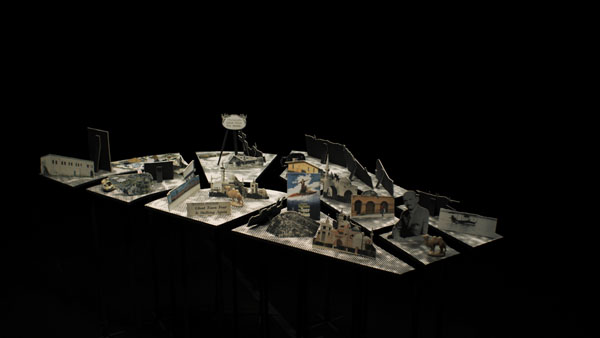Armand Morin, « All Type Displays » (dispositifs documentaires et documentés)

Armand Morin, étudiant au Fresnoy – Studio National des Arts Contemporains
Appelons dispositif documentaire l’exposition d’éléments documentant un sujet et dispositif documenté la documentation d’un dispositif d’exposition. Dans Opa-Locka will be beautiful (2011), l’inscription « All type displays », à l’entrée d’un hangar de la ville d’Opa-Locka, synthétise ces deux visées présentes dans les films d’Armand Morin. L’histoire de cette ville fondée au xxe siècle par G. Curtiss sur le thème des Mille et une nuits est ponctuée par des vues de plateformes avec archives et maquettes en deux dimensions. Le dispositif documentaire décrit alors la traduction d’un langage formel urbain vers un autre, filmique et muséographique. Le film Folies (2011) construit quant à lui une vision morcelée de ruines artificielles lithiques bâties par M. Siffait, réincarnées en pliage polygonal. Dans l’œuvre vidéographique de l’artiste, le montage peut alors incarner une allégorie de la mise en exposition, liant différents états de géométrisation de la matière et du processus de prise de forme. Déplacé en 1925 par W. R. Hearst à Miami, au temps où G. Grey Barnard importait des cloîtres européens entiers destinés au futur Cloisters Museum, le sujet du Monastère Espagnol (2010) est soumis à cette même pratique de documentation historique des dispositifs de mises en scène d’artefacts passés. Cette attention portée à l’actualisation du réel en objets de l’art et leur réintégration dans l’univers urbain se reflète dans ce lieu monacal aujourd’hui musée, monument, église, théâtre d’actions sociales et décor de tournages.
http://vimeo.com/armandmorin/videos

Armand Morin Opa-Locka will be beautiful, 2011. Vidéo HD, 21 min. Réalisation Armand Morin. Production / Produced by Le Fresnoy, Studio National des arts contemporains.
“All Type Displays” (documentary and documented arrangements)
Armand Morin, student at Le Fresnoy—Studio National des Arts Contemporains
Let us use the term ‘documentary arrangement’ to describe the display of factors documenting a subject, and ‘documented arrangement’ for the documentation of a display arrangement. In Opa-Locka will be beautiful (2011), the words “All type displays”, at the entrance of a shed in the town of Opa-Locka, sum up these two aims presented in Armand Morin’s films. The history of this town founded in the 20th century by G. Curtiss, on the theme of The Thousand and One Nights, is punctuated by views of platforms with archives and two-dimensional models. The documentary arrangement thus describes the translation of a formal urban language towards another which is filmic and museographic. The film Folies (2011), for its part, constructs a fragmented vision of artificial lithic ruins built by M. Siffait, reincarnated in polygonal folding. In the artist’s video work, the montage can therefore incarnate an allegory of the act of display, bonding different states of geometrization of the matter and of the process of formation. Moved in 1925 by W.R. Hearst to Miami, at the time when G. Grey Barnard was importing whole European cloisters earmarked for the future Cloisters Museum, the subject of Monastère Espagnol (2010) is subject to this same practice of historical documentation of the arrangements for presenting past artefacts. This attention paid to the updating of reality as art objects and their re-incorporation in the urban world is reflected in this monastic place which is today a museum, a monument, a church, a venue for social programmes, and a film décor.
http://vimeo.com/armandmorin/videos
articles liés
Anthropocenia
par Benedicte Ramade
Portfolio
par Geoffroy Mathieu et Bertrand Stofleth
Entretien avec Marc-Olivier Wahler
par Patrice Joly

